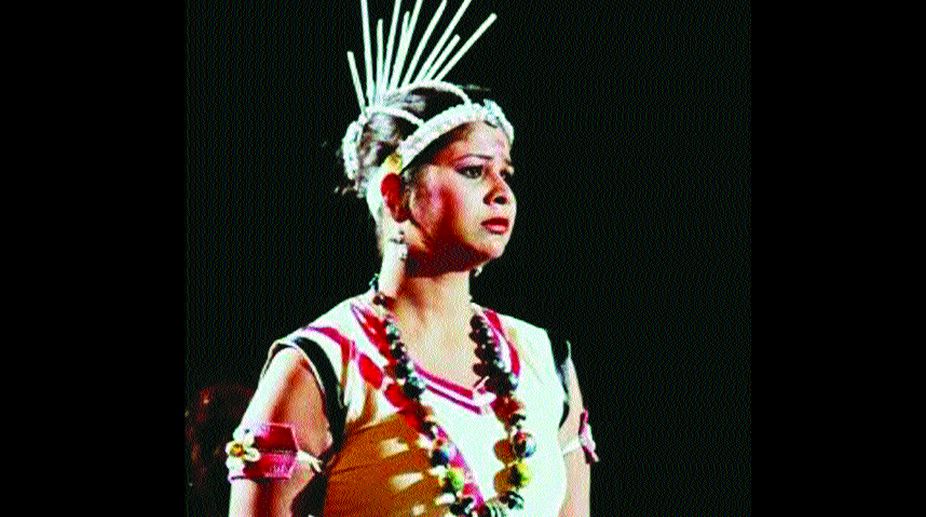Karna, in Mahabharata, was an unsung hero, and the classic Sanskrit poet Bhasa must have been one of the firsts to recognise that, which led to the play, Karnabharam, literally translating to ‘Karna’s burden’. The Kolkata audience got an opportunity to witness this marvel of a play in visual superiority at Rabindra Sadan, on 16 February, as a part of the Minerva Natya Sanskriti Charcha Kendra’s National Theatre Festival 2017, enacted by the group Indravati Drama Society from Madhya Pradesh, directed by Neeraj Kunder and Roshini Prasad Mishra.
The original play, composed in Sanskrit spanned only about four pages, and featured the final moment of glory for Karna in the battlefield before he went away after being defeated by Arjuna, but the performance incorporated all of Karna’s episodes in the epic, stretching it to about 75 minutes long, the dialect being a juxtaposition of Hindi and Bhageli, accompanied with original music by Kunder and Mishra themselves.
The play began with the Mangalacharn, typical in Bhageli style, followed by creating the famed ‘Narasimha’ formation which is the prologue of the original Sanskrit text. In the following scenes, Kunti becomes an unmarried mother, and sets afloat the newborn child in the river. It must be mentioned here that the production incorporated brilliant usage of light and shadow techniques, keeping the props to a bare minimum or practically none at all but without allowing the audience to notice being bereft of the same. The ‘Narasimha’ scene employed the use of reddish light and shadow effects to distort the faces into a beastlike impression, while the river scenes used blue lighting and a well synchronized movement of the hands to enumerate the waves of the river. Radha and Adhirath finding the abandoned child, his upbringing by them, Karna- Kunti dialogue, Bheeshma Pitamah lying on a bed of arrows, Karna being bitten by the Vajramukha insect, Karna entering the battle field as the new commander of Kaurava army, Karna-Arjuna’s battle, and death of Karna by Krishna’s deception are some of the other incidents shown in the play, finally ending with traditional Bhageli Manglakamana. Apart from brilliant performances, mention must be made of the fighting sequence between Karna and Parashurama where they first spar with spears, and then wrestle, and how the choreographed steps gradually rise in tempo is highly commendable in creating the perfect adrenalin rush and battle-like ambience for the audience.
Advertisement
The most renowned production of Karnabharam is probably by Kavalam Naraya Panikkar; Kunder had been a student under him for some years, learning about the nuances of Sanskrit and folk plays. In Panikkar’s production, we see the same actor playing the characters of Shalya and Parashurama in the scenes preceding and following the Vajramukha incident; Kunder integrated the same technique in his production as well, as it is only deemed fit that while Karna is having a flashback, and Shalya being the one shaking him back to reality, a different actor playing Parashurama at that time wouldn’t have had the same effect. Sheo Narayan Kunder, in this case, was a class apart as he effortlessly switched roles between Shalya and Parashurama, in the blink of an eye.
In Panikkar’s production, the Vajramukha was enacted by a man wearing an insect like mask with a sting, but Kunder outshone his master in this case, as his Vajramukha was formed by two men entangling their feet around each other’s waists and moving forward in a crawl. Here too shadow effects contributed brilliantly as the shadow of the two entangled men looked exactly like an intimidating insect.
Narendra Bahadur Singh’s performance as Karna was superb, successfully portraying all of Karna’s emotions, his anger at being thwarted by divine powers, his unfailing devotion to the Kauravas, his unparalleled compassion and his portrayal of “Danaveer.” Karna, who was doomed to death for no fault of his own and solely by inevitable circumstances he played no part in, becomes the true tragic hero of this classical Indian play and Singh was phenomenal in the exposé.
Original music by Kunder and Mishra played a big part in elevating the play, the chorus as well as “dhol” and “kasha” beats following each dialog to emphasise on the dramatic element and in maintaining the melodramatic aspect of Indian classical plays. However, in the scene where Karna gives away his armour to Lord Indra disguised as a priest, the melodrama went a tad too far as both the chorus and Shalya kept imploring him not to give it away over and over. The ending as well, after the duel between Karna and Arjuna as Krishna coming in disguise to demand Karna’s gold tooth was stretched a bit too long, unnecessarily adding extra melodrama.
Nevertheless, the play was an amazing success in its entirety, paying outstanding homage to Bhasa, to Karna the underrated hero who failed to receive his due glory, to Panikkar, and was the ideal performance to celebrate the love for theatre and will surely be remembered for years to come.
Advertisement











